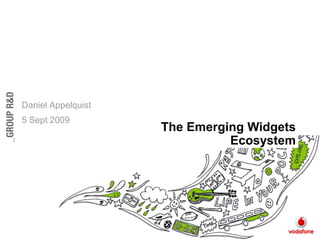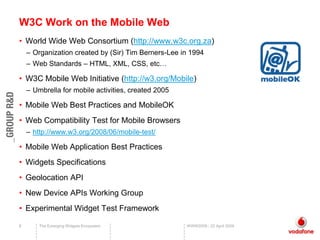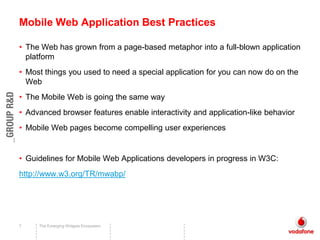Emerging Widgets Ecosystem - for Vodacom Widget Developer Camp
- 1. Daniel Appelquist5 Sept 2009The Emerging Widgets Ecosystem
- 2. The mobile Web isnŌĆÖt what It used to beŌĆ”The Emerging Widgets Ecosystem2
- 3. OperaŌĆÖs Mobile Web Usage Data (Jan 2009)The Emerging Widgets Ecosystem3
- 4. The Emerging Widgets Ecosystem4
- 5. Top 11 Mobile 2.0 Trends (from 2008)The Emerging Widgets Ecosystem5
- 6. W3C Work on the Mobile WebWorld Wide Web Consortium (http://www.w3c.org.za) Organization created by (Sir) Tim Berners-Lee in 1994Web Standards ŌĆō HTML, XML, CSS, etcŌĆ”W3C Mobile Web Initiative (http://w3.org/Mobile)Umbrella for mobile activities, created 2005Mobile Web Best Practices and MobileOKWeb Compatibility Test for Mobile Browsershttp://www.w3.org/2008/06/mobile-test/Mobile Web Application Best PracticesWidgets SpecificationsGeolocation APINew Device APIs Working GroupExperimental Widget Test FrameworkThe Emerging Widgets Ecosystem6WWW2009 - 22 April 2009
- 7. Mobile Web Application Best PracticesThe Web has grown from a page-based metaphor into a full-blown application platformMost things you used to need a special application for you can now do on the WebThe Mobile Web is going the same wayAdvanced browser features enable interactivity and application-like behaviorMobile Web pages become compelling user experiencesGuidelines for Mobile Web Applications developers in progress in W3C:http://www.w3.org/TR/mwabp/The Emerging Widgets Ecosystem7
- 8. Widget Test Framework (Experimental)Built on top of MobileOK Checkerhttp://qa-dev.w3.org:8001/widget/ (URL will change)Checks the level of compliance against the W3C Widget SpecificationsCode available here:http://dev.w3.org/cvsweb/2009/widget-checker/Keep watching this spaceThe Emerging Widgets Ecosystem8WWW2009 - 22 April 2009
- 9. W3C Standards is a Public ProcessAll these working groups operate ŌĆ£in publicŌĆØ ŌĆō on public mailing lists.W3C process includes a rigorous public comment periodThey want your feedback!Check out:W3C Web Applications public mailing list: http://lists.w3.org/Archives/Public/public-webapps/W3C Mobile Web Best Practices public mailing list:http://lists.w3.org/Archives/Public/public-bpwg/W3C Device APIs public mailing list:http://lists.w3.org/Archives/Public/public-device-apis/And follow progress at http://w3.org and http://w3.org/MobileThe Emerging Widgets Ecosystem9WWW2009 - 22 April 2009
- 10. The Emerging Widgets Ecosystem10WidgetsTake Mobile Web Applications to the next levelBuild mobile applications using Web technologies familiar to millions of developersPackage these Web applications up in a standard cross-platform way (W3C)Enable these applications with (secure) access to device capabilities through APIsDeploy into a Web Run-Time environment (analogous to a Web browser, but windowless and integrated into the device UI)Create a clear proposition for the developer and a route to marketCross-platform mini-applications, built on open Web standards that are easy to write and deploy and leverage a well-understood security model
- 11. Widgets Extend the WebWidgets use existing Web technologiesHTML, JavaScript, CSSPackaging and configuration standards being developed in W3CIn development in Web Applications working groupComplimentary to off-line capabilities of HTML5Widgets may be updated automaticallyAccess to device capabilities will be standardized as wellW3C Geolocation API working group ŌĆō referenced by OMTP BONDI, already implemented in iPhone 3.0 browser, Android, Opera test builds, MozillaŌĆ”OMTP BONDI interfacesMobile Widget Programme11
- 12. Widgets are at the epicenter of the Mobile <-> Web Convergence12
- 13. The Emerging Widgets Ecosystem13
- 14. The Emerging Widgets Ecosystem14The Twiggy StoryTwiggy ŌĆō the Mobile Twitter Search WidgetBuilt by Carsonifiedfor Vodafone to help promote mobile widgetsBuilt in 4 daysEmployed normal Web developer techniquesResulting application was wigitizable and also worked as a WebAppSocial search use case ŌĆō ideally suited for mobile widgetCase in point that itŌĆÖs easy for Web developers to build Widgets
- 15. Widgets: The Next ChapterStandard, secure access to device capabilitiesLocationCameraAddress bookCalendarMediaFile systemSensorsThe Emerging Widgets Ecosystem15
- 16. The Emerging Widgets Ecosystem16
- 17. Widget StandardsW3C standard for ŌĆ£Widget Packaging and ConfigurationŌĆØ completed this summerW3C standard for ŌĆ£Widget SigningŌĆØ completed this summerW3C standard for Widget APIs and Events pendingW3C standard for Widget Updates pendingWidget content is built on Web standards (HTML, CSS, JavaScript)Widgets are part of the Web ecosystemFragmented implementations are out there especially around APIs and security modelNokia widgets, Opera Widgets, BONDI widgets, JIL widgets, etcŌĆ”New W3C Device APIs working group working on one agreed set of APIsAll players at the table: Opera, Nokia, Vodafone, BONDI, Google, Mozilla, MicrosoftNokia and Vodafone co-chairing this effortDelivery probably in 2010The Emerging Widgets Ecosystem17
- 18. Mobile Widgets Are Made for the Social WebSocial applications for people on the goNew mechanisms for communicationBringing your social network with youProximity-based applicationsLocation-aware social appsMobile location-based gamingUbiquitous access to information and communicationThe Emerging Widgets Ecosystem18
- 19. ResourcesWidget blog: http://betavine.net/widgetblogW3C: http://www.w3c.org.zaOMTP BONDI: http://www.omtp.org/bondi



















